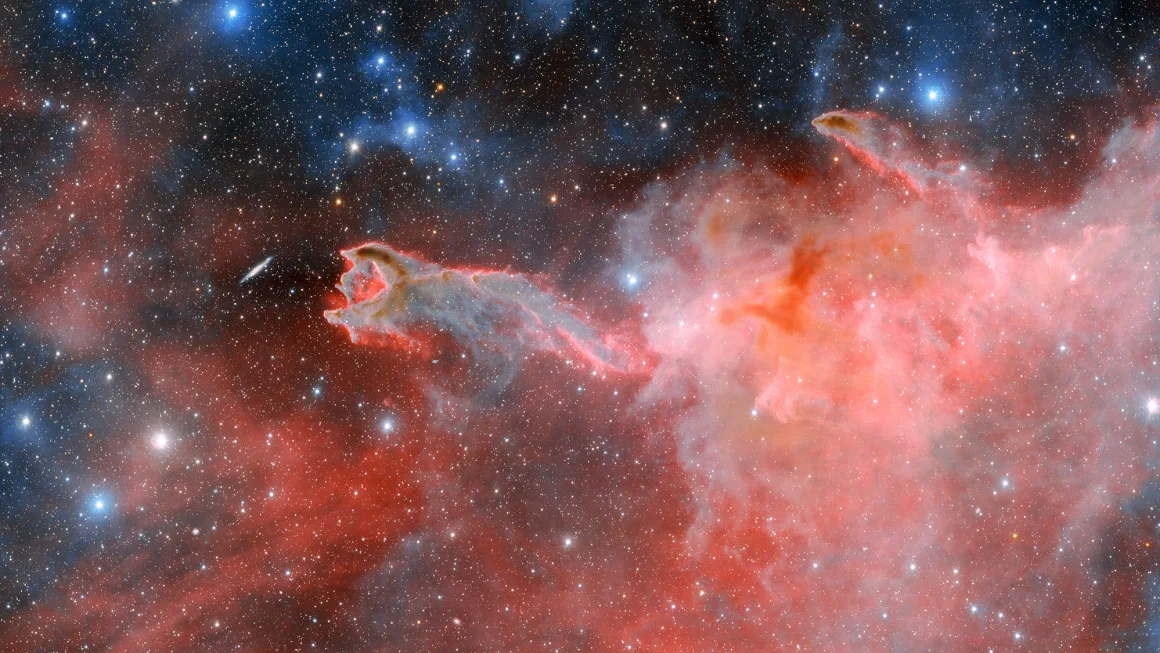(CNN) — A rarely-seen cosmic phenomenon appears to appear as a ghostly arm reaches across the universe toward a helpless spiral galaxy in a new telescope image, according to astronomers.
The Dark Energy Camera is a stunning image The “Hand of God” is a comet globular in the Puppis constellation, 1,300 light-years from Earth. Victor M. at the Cerro Tololo Inter-American Laboratory in Chile. The camera is mounted on a Blanco 4 meter telescope.
Cometary globules are a type of bog globule or dark nebula. These isolated cosmic clouds are filled with dense gas and dust, surrounded by hot, energetic material. Comet globules are unique because they have extended tails like those found in comets, but that is the only cometary thing about them.
Astronomers still don't know how cometary spheres form in such unique structures. Historically, detecting weak clouds has been difficult for scientists.
A new image of a bright red arm-like feature shows CG 4, one of many cometary globules found in the Milky Way. The twisted cloud appears to reach the spiral galaxy ESO 257-19 (PGC 21338). But the galaxy is 100 million light-years away from the cometary sphere.
CG 4 has a dusty, arm-like main head that measures 1.5 light-years across and a long tail about 8 light-years across. A light year is the distance light travels in one year, which is 9.46 trillion kilometers (5.88 trillion miles).
An amazing celestial discovery
Astronomers first discovered cometary globules by chance in Australia in 1976 while looking at images taken by England's Schmidt Telescope. These cosmic events are difficult to detect because they are incredibly faint and the tails of the globules are often obscured from view by stellar dust.
But the dark energy chamber has a special filter that detects the incredibly faint red glow emitted by ionized hydrogen, which is on the outer rim and head of CG 4. Hydrogen produces such a red glow only after being hit by nearby radiation. Giant stars.
While interstellar radiation allows the comet globule to be seen, over time it also destroys the globule's head. However, there is enough gas and dust within the globule to support the birth of many stars like our Sun.
Comet globules can be found throughout our galaxy, but most are found in the Comet Nebula, a bright gas cloud thought to be the remnants of a slowly expanding stellar explosion from about 1 million years ago. The Gum Nebula is believed to contain 31 cometary spheres in addition to 4 CGs.
Astronomers believe there are two ways the globules get their unique, comet-like shapes.
The globules may have once been circular nebulae, like the iconic Ring Nebula, that were disrupted by a supernova over time, perhaps even forming the Gum Nebula.
But cosmic events can also be the result of winds and radiation emitted by nearby massive, hot stars.
Astronomers believe that stars may be the underlying reason why all cometary globules found in the Gum Nebula have tails that point away from the nebula's center. And at the center of the nebula are supernova remnants and a pulsar, or fast-spinning neutron star, formed when a massive star collapsed and exploded.





:quality(85)/cloudfront-us-east-1.images.arcpublishing.com/infobae/KTKFKR763RBZ5BDQZJ36S5QUHM.jpg)